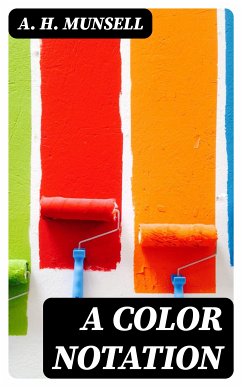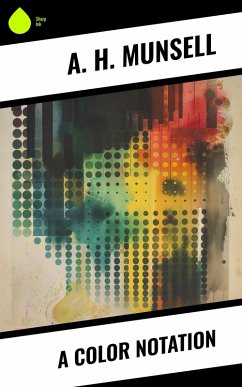
A Color Notation (eBook, ePUB)

PAYBACK Punkte
0 °P sammeln!
A. H. Munsell's *A Color Notation* is a pioneering exploration of color theory that employs a systematic approach to color classification and identification. Published during the early 20th century, Munsell's work is marked by a meticulous organization of colors into categories based on hue, value, and chroma. The richly illustrated volume serves as both an artistic manifesto and a scientific inquiry, bridging the gap between aesthetic experience and empirical study. Munsell's innovative color wheel and notation system not only challenged existing paradigms but also established a framework tha...
A. H. Munsell's *A Color Notation* is a pioneering exploration of color theory that employs a systematic approach to color classification and identification. Published during the early 20th century, Munsell's work is marked by a meticulous organization of colors into categories based on hue, value, and chroma. The richly illustrated volume serves as both an artistic manifesto and a scientific inquiry, bridging the gap between aesthetic experience and empirical study. Munsell's innovative color wheel and notation system not only challenged existing paradigms but also established a framework that continues to influence fields such as art, design, and education today. A. H. Munsell, a painter and educational reformer, was deeply influenced by his interest in how color perception affects artistic expression and environmental design. His experiences in teaching art and his frustrations with the vagueness of color terminology motivated him to create a comprehensive, standardized system that would allow artists, students, and scientists alike to communicate more effectively about color. Munsell's dedication to systematic observation and classification is evident throughout his work, reflecting the scientific aspirations of his time. Readers seeking a profound understanding of color and its applications will find *A Color Notation* an indispensable resource. Munsell's groundbreaking insights not only foster enhanced visual literacy but also invite readers to reconsider how they perceive and utilize color across various disciplines. This book is essential for artists, designers, educators, and anyone interested in the intricate relationship between color and human perception.
Dieser Download kann aus rechtlichen Gründen nur mit Rechnungsadresse in A, B, BG, CY, CZ, D, DK, EW, E, FIN, F, GR, H, IRL, I, LT, L, LR, M, NL, PL, P, R, S, SLO, SK ausgeliefert werden.













